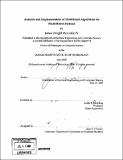Analysis and implementation of distributed algorithms for multi-robot systems
Author(s)
McLurkin, James D. (James Dwight), 1972-
DownloadFull printable version (64.96Mb)
Other Contributors
Massachusetts Institute of Technology. Dept. of Electrical Engineering and Computer Science.
Advisor
Leslie P. Kaelbling.
Terms of use
Metadata
Show full item recordAbstract
Distributed algorithms for multi-robot systems rely on network communications to share information. However, the motion of the robots changes the network topology, which affects the information presented to the algorithm. For an algorithm to produce accurate output, robots need to communicate rapidly enough to keep the network topology correlated to their physical configuration. Infrequent communications will cause most multirobot distributed algorithms to produce less accurate results, and cause some algorithms to stop working altogether. The central theme of this work is that algorithm accuracy, communications bandwidth, and physical robot speed are related. This thesis has three main contributions: First, I develop a prototypical multi-robot application and computational model, propose a set of complexity metrics to evaluate distributed algorithm performance on multi-robot systems, and introduce the idea of the robot speed ratio, a dimensionless measure of robot speed relative to message speed in networks that rely on multi-hop communication. The robot speed ratio captures key relationships between communications bandwidth, mobility, and algorithm accuracy, and can be used at design time to trade off between them. I use this speed ratio to evaluate the performance of existing distributed algorithms for multi-hop communication and navigation. Second, I present a definition of boundaries in multi-robot systems, and develop new distributed algorithms to detect and characterize them. Finally, I define the problem of dynamic task assignment, and present four distributed algorithms that solve this problem, each representing a different trade-off between accuracy, running time, and communication resources. All the algorithms presented in this work are provably correct under ideal conditions and produce verifiable real-world performance. (cont.) They are self-stabilizing and robust to communications failures, population changes, and other errors. All the algorithms were tested on a swarm of 112 robots.
Description
Thesis (Ph. D.)--Massachusetts Institute of Technology, Dept. of Electrical Engineering and Computer Science, 2008. Includes bibliographical references (p. 159-166).
Date issued
2008Department
Massachusetts Institute of Technology. Department of Electrical Engineering and Computer SciencePublisher
Massachusetts Institute of Technology
Keywords
Electrical Engineering and Computer Science.